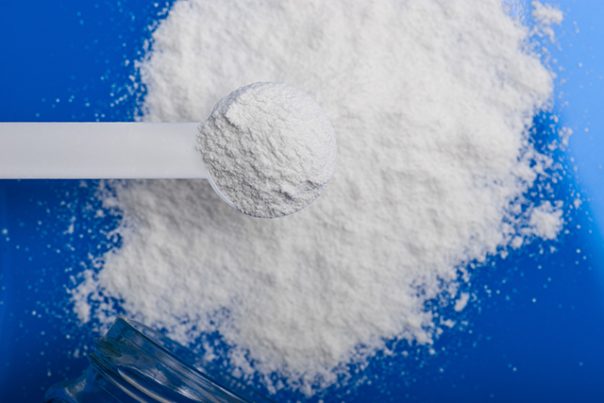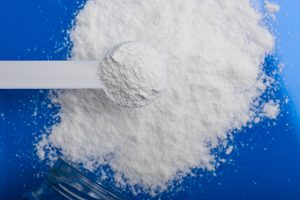
Ammonium chloride sources, health risks
Thursday, October 05, 2017 by Jhoanna Robinson
http://www.naturalpedia.com/ammonium-chloride-sources-health-risks.html

Ammonium chloride is a colorless, coarse, or fine crystalline substance that is highly soluble in water (37 percent), and thus can readily form into an acidic solution. It vaporizes without melting at 340 degrees Celsius (644 degrees Fahrenheit) to make equal volumes of ammonia and hydrogen chloride.
Ammonium chloride results as a by-product during the ammonia-soda process for making sodium carbonate and is also yielded when ammonium sulfate and sodium chloride solutions react. When ammonium chloride is combined with slaked lime (calcium carbonate), ammonia gas becomes the end-product.
Ammonium chloride is a systemic and urinary acidifying salt that helps maintain the body’s pH levels (acid-base balance).
Ammonium chloride is a component of many cold and cough medicines due to its effectiveness as an expectorant. In veterinary medicine, it is an ingredient to a mixture that is given to cattle, goats, and sheep to treat urinary stones.
It can also be used as a diuretic, especially when used in combination with a xanthine diuretic (for example, caffeine, pamabrom) to relieve temporary water-weight gain bloating, edema, or a full feeling that has been experienced in correlation with premenstrual or menstrual periods.
Ammonium chloride is also used as fertilizer for crops in rainy climates, particularly for rice, though it is not currently registered for use in the United States. It is also utilized as a flux in zinc and tin plating; in the manufacture of printed circuit boards; in dry and Leclanche batteries; in the manufacture of explosives; as a flame suppressant; as a hardener for formaldehyde-based adhesives; and as a dye mordant.
Pregnant mothers have been warned against exposure to ammonium chloride as it can cause congenital abnormalities to the fetus in the womb. Threats to environmental degradation and contamination are also high.
Harmful effects that can be caused by ammonium chloride
Overexposure to ammonium chloride can cause irritation of the eyes and the skin. Other side effects of too much ammonium chloride exposure are rashes, headache, hyperventilation, and progressive drowsiness.
Ammonium chloride can increase blood suar levels. It is known to cause hyperglycemia, a condition characterized by abnormally high blood glucose levels.
People who have been exposed to too much ammonium chloride levels also suffer from potassium depletion.
Body systems harmed by ammonium chloride
Ammonium chloride is bad for the respiratory system. It can cause asthma, coughing, dyspnea or labored breathing, and pulmonary sensitization. Pulmonary lesions in the lungs can surface, causing even more serious health issues such as alveolar edema, alveolar emphysema, hemorrhage, tubules, and hyperemia, or an excess of blood in the vessels.
Ammonium chloride is bad for the excretory system. It can lead to metabolic acidosis, a condition when the body is producing too much acids or when the kidneys are having difficulties when it comes to getting rid of acids in the body.
It can also cause hyperchloremia, which occurs when there is an abnormally elevated level of ion chloride in the blood. Renal and liver function are also impaired, with the liver being unable to convert ammonium ion to urea. Diuresis, or a tendency of the body to produce too much urine when it is experiencing an abnormality, can also occur.
There have also been reports that hepatocytes – a cell of the main parenchymal tissue of the liver – that have been exposed to ammonium chloride can lead to hepatic failure, of which hyperammonemia and jaundice are the most common clinical symptoms.
Ammonium chloride is bad for the cardiovascular system. It can lead to bradycardia, which is characterized by an extremely slow heart rate (under 60 beats per minute).
Ammonium chloride is bad for the central nervous system. Too much exposure to it can bring about mental confusion, and, in worst-case scenarios, phases of excitement alternating with coma. It can also cause electroencephalogram (EEG) abnormalities.
Ammonium chloride is bad for the endocrine system. It can bring about calcium-deficient tetany, which is a condition that is characterized by muscle spasms due to the malfunctioning of the parathyroid glands. It also causes twitching and hyperreflexia, a condition in which your involuntary nervous system overreacts to stimuli.
Ammonium chloride is bad for the immune system. It can cause dysfunction to the whole immune cell family. It can also bring about leukocytosis, which occurs when there is an abnormal overproduction of white blood cells in the body, causing the body to lower its defenses against disease-causing infections.
Ammonium chloride is bad for the digestive system. It can cause nausea, abdominal pain, and vomiting.
Ammonium chloride is bad for the ocular system. It can cause the degeneration of the ganglion cell layer of the retina.
Where to learn more
- TOXIC WARNING: Fruit & Vegetable Stickers – Organic Makes Zero Difference!
- Why McDonald’s Happy Meal hamburgers won’t decompose – the real story behind the story
- Chemicals used in common household disinfectants significantly impair reproductive health
- Governor Schwarzenegger Backs Aerial Biochemical Spraying That Harms Children
Summary
Ammonium chloride is bad for the cardiovascular, central nervous, endocrine, immune, digestive, respiratory, excretory, and ocular systems.
People who have been exposed to too much ammonium chloride suffer from potassium depletion.
Threats to environmental degradation and contamination due to ammonium chloride exposure are high.
Sources include:
Tagged Under: Tags: ammonium chloride






